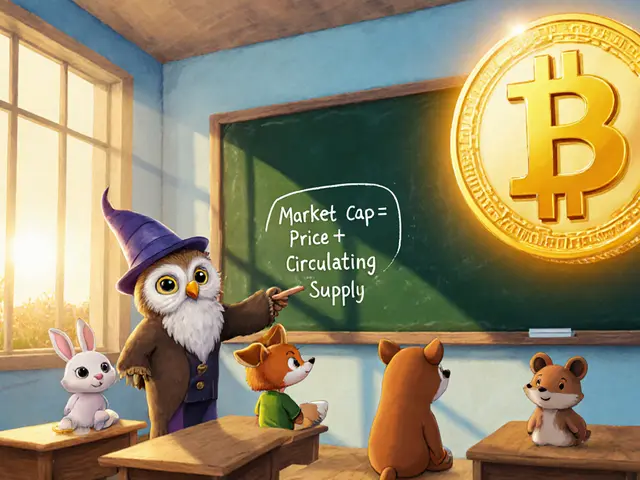Crypto Market Cap Predictor
Enter values and click "Analyze Investment Potential" to see detailed analysis.
When people talk about market capitalization the total dollar value of a digital asset, calculated as price multiplied by circulating supply, the first thing they usually want to know is whether a big number means a bright future. It’s a natural question: if Bitcoin tops the list with a trillion‑dollar market cap, does that guarantee it will keep leading? Or can a small‑cap token suddenly become the next big thing? Below we break down what the data actually say, where market cap falls short, and which extra signals give a clearer picture of crypto success.
Key Takeaways
- Market cap is great for ranking size but weak as a solo predictor of future returns.
- Higher‑variance (i.e., more volatile) coins often deliver lower subsequent returns, contradicting traditional risk‑reward logic.
- Multi‑factor models that blend macro‑economic cues, technical indicators, and sentiment analysis consistently outperform pure market‑cap forecasts.
- For everyday investors, treat market cap as a starting filter, then add volatility, on‑chain activity, and news sentiment before making a call.
What Exactly Is Market Capitalization in Crypto?
In the crypto world, market capitalization equals the current price of a coin multiplied by the number of coins that are actually circulating. Unlike stocks, where shares are fixed, crypto supply can change via mining, staking, or token burns, so the metric can shift dramatically in a short period.
Platforms like CoinMarketCap a price aggregation site launched in 2013 that standardizes market‑cap data across thousands of tokens and CoinGecko another aggregator that adds developer activity and community metrics to its rankings have made market‑cap numbers instantly visible to anyone with an internet connection.
Why Market Cap Became the Go‑To Ranking Tool
Investors love a single number that tells a story. Early research found that the top‑5 cryptocurrencies by market cap consistently outperformed the broader market over a 12‑month horizon. That finding fed into the popular “large‑cap safe zone” narrative and helped shape the first generation of crypto index funds.
But the same studies also noted a paradox: the very same high‑cap assets often show lower volatility, which can dampen upside potential compared with mid‑cap projects that swing wildly. In other words, a bigger market cap can mean a steadier ship, not necessarily a faster one.

Academic Evidence: Market Cap’s Predictive Power-or Lack Thereof
Several peer‑reviewed papers have tried to answer the core question directly. One variance‑decomposition study treated market cap as a control variable and discovered that “cryptocurrencies with higher variances tend to provide lower returns in subsequent periods.” This runs counter to classic finance theory where higher risk usually commands higher expected returns.
Another line of work introduced the CryptoPulse model a multi‑factor forecasting framework that blends macro‑economic environment, technical indicators, and sentiment analysis. When researchers added CryptoPulse’s extra features, prediction errors (MAE and MSE) dropped between 10% and 70% for the top 5 assets, showing that market cap alone left a huge accuracy gap.
Even when market‑cap‑weighted indices like the S&PBDMI were examined, the correlation with traditional macro variables (inflation expectations, interest rates) hovered near 0.10-hardly enough to treat market cap as a reliable economic barometer.
Limitations of Relying Solely on Market Cap
- Supply dynamics: Token burns, staking rewards, or new issuance can instantly change market cap without any price movement.
- Liquidity blind spot: A coin can have a $10billion market cap but only $5million in daily trading volume, making price spikes possible.
- Volatility mismatch: High‑cap assets often have lower variance, which translates into weaker subsequent returns in the crypto space.
- Directional prediction failure: Models that score well on MAE/RMSE can still miss the direction of price moves-something traders care about more than raw error metrics.
Better Predictors: Multi‑Factor Approaches
Since market cap fell short, researchers turned to richer data sets. Below is a quick side‑by‑side of the three most common predictive lenses.
| Factor | Predictive Strength (empirical) | Key Advantage |
|---|---|---|
| Market Capitalization | Low-Medium | Simple, widely available |
| Volatility & Variance | Medium | Captures risk dynamics unique to crypto |
| Technical Indicators (RSI, MACD, moving averages) | Medium-High | Reflects price momentum and reversal patterns |
| Macro‑Economic Environment (interest rates, policy shifts) | High | Links crypto cycles to broader financial trends |
| Sentiment Analysis (Twitter, Reddit, news) | High | Detects hype‑driven price surges early |
| On‑Chain Metrics (active addresses, hash rate) | High | Provides real‑world usage signals beyond price |
Notice that every factor except pure market cap needs at least two data inputs, but the extra effort is rewarded with considerably tighter forecasts.

Practical Checklist for Investors
- Start with market cap to filter out coins that are too small to be liquid.
- Calculate 30‑day and 90‑day price variance; avoid assets with extreme upside‑down variance patterns.
- Run a simple technical indicator suite (RSI, MACD, 50‑day SMA) on the price chart.
- Pull macro‑economic snapshots - look at recent Fed rate decisions or major policy announcements.
- Scan sentiment on Twitter, Reddit, and major news outlets using a free tool like CryptoPulse the sentiment‑fusion component of the CryptoPulse model or alternative sentiment APIs.
- Cross‑check on‑chain activity: active wallet count, transaction volume, and hash‑rate (for PoW coins).
- Rank the coins by a weighted score (e.g., 30% market cap, 20% volatility, 20% technical, 15% macro, 15% sentiment). Choose the top few for deeper due‑diligence.
Following this list gives you a data‑rich view without needing a PhD in econometrics.
When Market Cap Still Matters
If you’re building a passive crypto index fund or a diversified portfolio, market cap remains a useful anchor. Selecting the top 10‑20 assets by market cap creates a basket that historically shows smoother returns than a random selection. However, even in that context, periodic rebalancing based on volatility and on‑chain health can boost performance by 5‑10% per year.
Common Pitfalls to Avoid
- Assuming a larger market cap guarantees price stability - large caps can still crash hard during market panics.
- Ignoring supply changes - a token that burns 10% of its supply each quarter will see its market cap shrink without any price drop.
- Relying only on MAE/RMSE figures - a model might predict the exact price but get the direction wrong, which is useless for trading.
- Neglecting macro shocks - sudden regulatory bans or monetary policy shifts have knocked both Bitcoin and smaller tokens off their trends.
Frequently Asked Questions
Does a higher market cap mean lower risk?
Generally, yes. Large‑cap coins like Bitcoin and Ethereum trade with higher liquidity and lower price swings than many small‑cap projects. But "lower risk" only applies to short‑term price jitter, not to long‑term systemic shocks like regulation or macro‑economic crises.
Can I use market cap alone to pick a winner?
No. Market cap is a starting filter. Successful picks usually combine cap with volatility, on‑chain activity, and sentiment. Ignoring those signals leads to many false‑positive picks.
How often should I rebalance a market‑cap‑based portfolio?
Quarterly rebalancing works well for most passive investors. It captures major supply events and shifts in macro‑economic sentiment without incurring excessive trading costs.
What is the easiest way to add sentiment data?
Free APIs like the Reddit‑Crypto‑Sentiment or the Twitter‑Crypto‑Score can pull daily sentiment scores. Plug those numbers into a simple spreadsheet alongside market cap and volatility for a quick composite score.
Do macro‑economic factors affect small‑cap tokens?
Yes. Studies show both bull and bear runs in crypto coincide with periods of ultra‑loose or tightening monetary policy, regardless of a token’s size. Small caps can be even more sensitive because they lack deep liquidity buffers.







Petrina Baldwin
October 10, 2025 AT 04:46Market cap is just a number. I bought a coin with $200M cap last year. Now it's $2B. Who cares what the chart says?
Ralph Nicolay
October 10, 2025 AT 09:08It is imperative to acknowledge that market capitalization, while statistically convenient, constitutes an insufficient metric for predictive modeling in decentralized asset valuation due to its inability to account for non-price-based economic indicators.
sundar M
October 10, 2025 AT 11:57Brooo this is SO TRUE!! 🙌 I was just talking to my cousin in Bangalore and he said he bought Shiba because it had low cap and now he's laughing all the way to the bank! Market cap is just the starting point, not the finish line. Add on-chain, add sentiment, add your gut feeling - that’s how you win in crypto. 💪🔥
Nick Carey
October 10, 2025 AT 12:26Ugh. Another crypto nerd essay. Can we just buy the dip and go to bed?
Sonu Singh
October 10, 2025 AT 13:46Yo i been usin on chain data for 2 years now and its way better then market cap. Look at active addys and txns - if a coin got 10k daily wallets but only 500M cap? Thats a bomb. Market cap dont mean nothin if no one usin it. Also watch for token burns - they change cap without price movin. Lol
Peter Schwalm
October 10, 2025 AT 21:45Great breakdown. I’ve been telling people for years: market cap is like judging a car by its sticker price - it tells you nothing about the engine, the tires, or if the owner actually drives it. On-chain metrics and sentiment are the real diagnostics. I use a simple spreadsheet with weighted scores - works better than any fancy AI tool.
Alex Horville
October 11, 2025 AT 10:19Why are we even talking about this? Crypto is a Western scam. China and Russia are building real digital currency systems. Let the Americans waste their time on meme coins and market cap fantasies.
Marianne Sivertsen
October 12, 2025 AT 04:57It’s funny how we treat numbers like they’re destiny. Market cap is just a snapshot - a photo of a person at one moment. But people? They change. Coins change. The world changes. Maybe the real question isn’t ‘what does the cap say?’ but ‘what is this asset becoming?’
Shruti rana Rana
October 12, 2025 AT 17:22Love this post! 🌟 From India, I’ve seen how small-cap tokens explode when the community rallies - and how big caps crash when FOMO fades. Sentiment + on-chain = real power. Also, please use CryptoPulse! It’s free and works wonders. 🙏
Stephanie Alya
October 12, 2025 AT 20:47Oh wow, so we’re pretending market cap is useless now? 🤡 I bought BTC at $30k because it had the biggest cap. Now it’s $70k. Your ‘multi-factor model’ didn’t predict that. Just sayin’.
olufunmi ajibade
October 13, 2025 AT 04:13As a woman in Nigeria trying to educate others on crypto, I can say this: market cap is the first thing people see - and it’s the last thing they should trust. I teach my sisters to check wallet distribution and transaction volume. If one address holds 40% of supply? Run. Not all that glitters is gold - especially in crypto.
Manish Gupta
October 13, 2025 AT 09:41What about the time when a coin had low cap but huge dev activity? Like when Solana was $2 and had 100+ commits a day? That’s the real signal. Market cap is just noise.
Gabrielle Loeser
October 14, 2025 AT 05:15The structural limitations of market capitalization as a standalone indicator are well-documented. However, its utility in portfolio construction, particularly for passive investors, remains statistically valid. One should not discard a tool because it is imperfect, but rather integrate it within a broader analytical framework.
Cyndy Mcquiston
October 15, 2025 AT 02:05Market cap is dead. Long live on-chain. That’s it.
Abby Gonzales Hoffman
October 15, 2025 AT 10:46YES! This is exactly what I’ve been saying since 2021. Stop chasing big numbers. Look at active wallets. Look at Twitter chatter. Look at whether devs are still pushing code. I use a free Google Sheet with those 6 filters - and I’ve doubled my money twice. You don’t need a PhD. You just need to look past the headline.
Rampraveen Rani
October 15, 2025 AT 14:45Bro if you dont check hash rate and active addresses you are literally gambling. Market cap is like checking a car’s color before buying it. I made 5x on a coin with 50M cap because its daily txns went from 5k to 50k. No one was talking about it. That’s the edge.
ashish ramani
October 16, 2025 AT 04:47Market cap is a useful reference point, but it must be contextualized with liquidity, supply dynamics, and network usage. Without these, any investment decision is incomplete.
Natasha Nelson
October 16, 2025 AT 07:11Okay, but… what if you’re just trying to get rich quick? Do you really need all these charts? I just follow the biggest names. I don’t care if it’s ‘accurate.’ I care if it goes up. 😅
Sarah Hannay
October 17, 2025 AT 01:25While the empirical evidence presented is compelling, it is important to recognize that market capitalization serves a foundational role in risk diversification. Its removal from the evaluation process entirely may introduce unintended bias toward speculative assets with limited liquidity and high volatility.
Richard Williams
October 17, 2025 AT 05:09Hey, I appreciate this. I used to be the guy who only looked at market cap. Then I lost 60% on a ‘big cap’ coin that got dumped by whales. Now I use the checklist you posted - and I sleep better. Seriously, do the 6-step thing. It’s not sexy, but it works.